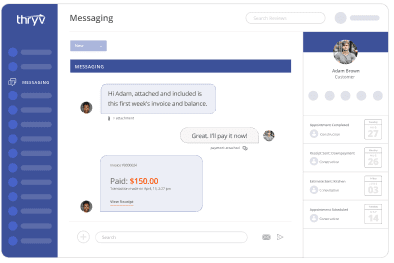 A customer sees your van rolling through the neighborhood or calls to make an appointment or visits your website or reads an online review of your service or gets a bill in the mail or returns a purchase—they’re all “touchpoints” where your business makes an impression.
A customer sees your van rolling through the neighborhood or calls to make an appointment or visits your website or reads an online review of your service or gets a bill in the mail or returns a purchase—they’re all “touchpoints” where your business makes an impression.
Get them right and you win and keep loyal customers.
Get them wrong and you’ll have lots of company: The average small business loses half its customers in three years, according to small biz management expert Barry Moltz.

Free Guide: The Modern Small Business Playbook
DownloadFind your touchpoints
Really, this is just about looking at your business through the eyes of your customers.
Make a “customer journey map” (it could be as simple as lines and boxes drawn on a legal pad or sticky notes arranged on a wall) that covers the touchpoints from first awareness through consideration through purchase through ongoing service to repeat purchase to spreading the word about your business to friends. Touchpoints could happen in person, on the phone, on your website or on social media or email.
Some approaches to thinking through a touchpoints map:
- Channels. If the journey started with hearing a radio ad or reading an online review, what path would the customer take?
- Personas or customer types. How would a young hipster or an elderly widow start and complete the journey?
- Problems to solve. If a customer has a leaky roof or an aching tooth, how does she find and use your business?
Keep it simple to start. Focus on one part of the map, say new customer intake or returns and refunds. Study the process thoroughly: Listen in on phone calls, watch employees at work, do the tasks yourself, talk to customers and ask them to take a survey.
Fix your touchpoints
Once you’re in touch with your touchpoints, it’s time to start asking some pointed questions from the customer’s point of view. Like these (hat tip to this article from the Harvard Business Review for some of the questions):
- Are there too many or too complicated touchpoints that make the customer work too hard?
- Are the touchpoints addressing customers’ motivations, and answering their questions?
- Are the touchpoints addressing your customers’ needs? Are any needs left unspoken?
- Do any touchpoints put the convenience of employees ahead of customer needs?
- Do all the touchpoints present your brand in a consistent way?
- Are there interruptions in the journey that might cause customers to give up?
- Do the touchpoints give you a competitive advantage versus competitors?
High risk/high reward touchpoints: Moments of Truth
Some touchpoints can become Moments of Truth, when suddenly the whole relationship between business and customer is at stake (for an entertaining explanation of MOT, see this video). These could be moments of high emotion, such as an angry complaint. But they could be innocuous, everyday events.
You walk into a store and ask a salesperson where to find an item.
Possible answer #1: “Oh, I think it’s in the back somewhere.”
Possible answer #2: “In the back on aisle 10. Let me take you there right now.”
Result either way: Moment of Truth.
Richard Normann, the Swedish business professor who developed the concept of Moments of Truth, said that it takes 12 good moments to counter the effect of one bad moment. Normann also thought that good and bad moments tend to drive customer relations from good to better or from bad to worse as both customers and employees come to expect more of the same in the contacts that follow.
Normann advised SAS, the Swedish airline, on a successful turnaround in the 1980s, led by Jan Carlzon, who wrote a book about the experience, called Moments of Truth. Carlzon wrote that every single contact between employee and customer, even for a few seconds, “are the moments that ultimately determine whether SAS will succeed or fail as a company”.
To set up each moment for a win, Carlzon did two things:
- Gave employees a book laying out company goals and values so everyone was literally on the same page
- Empowered employees to fix customer problems
Carlzon had this to say about his company: “SAS is not a collection of material assets, but the quality of the contact between an individual customer and the SAS employees who serve the customer directly.” Substitute the name of your company and see how it feels.

Modern Small
Business Playbook
Modernize your business, get paid faster and win more customers.




